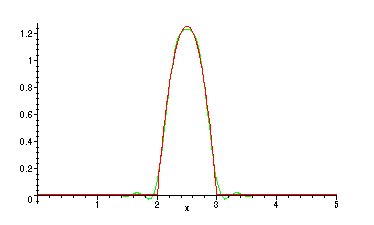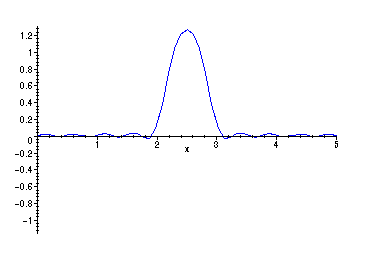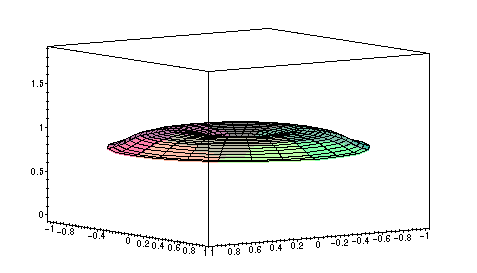![[Maple Math]](images/AM01FPS1.gif)
MATH 373 -- Applied Mathematics (PDE)
Final Problem Set -- Selected Solutions
I A)
The initial string shape:
> f:=piecewise(x<2,0,x<3,5*(x-2)*(3-x),x<5,0);
![[Maple Math]](images/AM01FPS1.gif)
The eigenfunctions of the boundary value problem
X'' = -
![]() X
X
X(0) = X(5) = 0
are X(
x
) =
![[Maple Math]](images/AM01FPS3.gif) , n >= 1. The corresponding solution of
, n >= 1. The corresponding solution of
the 1D wave equation looks like:
![[Maple Math]](images/AM01FPS4.gif)
Since
![]() , it follows that
, it follows that
![]() for all
n .
The
for all
n .
The
![]() come from the usual
come from the usual
coefficient formulas for a Fourier sine series for the initial string shape on [0,5]
> A:=n->evalf(2*Int(f*sin(n*Pi*x/5),x=0..5)/5);
![[Maple Math]](images/AM01FPS8.gif)
The partial sum of the Fourier sine series for the initial string shape
> PSFS:=(N,x)->add(A(n)*sin(n*Pi*x/5),n=1..N);
Warning, `n` in call to `add` is not local
![]()
Taking N = 25 gives close agreement with the initial string shape above.
> plot({f,PSFS(25,x)},x=0..5);

> PSu:=(N,x,t)->add(A(n)*sin(n*Pi*x/5)*cos(n*Pi*t/5),n=1..N);
Warning, `n` in call to `add` is not local
![]()
> with(plots):
> animate(PSu(20,x,t),x=0..5,t=0..10,frames=30,color=blue);

The animation shows the intial peak between x = 2 and x = 3 splitting up into
two peaks of one half the height, one moving left, one moving right. When those
peaks reach the endpoints at x = 0,5 they are reflected so that they move back in
the opposite direction. They are also reflected across the x - axis in the process.
The smaller peaks then "recombine" momentarily below the x - axis, continue
moving in their new directions until they are reflected in the same way at
the opposite endpoints. The cycle then repeats.
D) The reflection of waves at the endpoints seen above can be explained using
the result of part C, which says that the D'Alembert solution of the problem
![]()
![]()
![]() ,
,
namely
![[Maple Math]](images/AM01FPS16.gif) , where F is the odd periodic extension of
, where F is the odd periodic extension of
f , restricted to the interval [0,5] in x, equals the solution of our problem.
The graph of the odd periodic extension, F( x ) has peaks like that in the graph
of f, but below the x-axis, in the intervals [-13, -12], [-3,-2], [ 7,8], [17,18]
etc. In the D'Alembert solution we have two traveling waves, one moving
to the left at constant speed 1, one moving to the right at the same speed. Between
t = 2 and t = 7, for instance, when the plot above shows the reflected wave below
the x-axis, we are seeing the portions of the right-moving and left-moving
waves from the D'Alembert solution that started out in [-3,-2] (moving right),
and [7,8] (moving left) respectively. (In a physical string, the waves really are
reflected by the endpoints, but that behavior "comes mathematically" from the
fact that the restriction of the D'Alembert solution with the odd periodic
initial data is another way to write the solution of this problem.)
III.
A) The three ODE's from this problem are
T
' = -
![]()
![]() '' =
'' =
![]()
R
'' +
![]() R
+ (
R
+ (
![[Maple Math]](images/AM01FPS21.gif) )
R
= 0
)
R
= 0
The boundary condition
![]() , all
, all
![]() says
R'(a) = 0.
says
R'(a) = 0.
B) The fact that
![]() has an infinite sequence
has an infinite sequence
![]() where
where
![]() '(
'(
![]() ) = 0 follows from the Mean Value Theorem. Because
) = 0 follows from the Mean Value Theorem. Because
we know that the Bessel function has an infinite sequence of zeros,
the numbers we called
![]() in class, on each interval between
in class, on each interval between
two consecutive zeros
![]() and
and
![]() of
of
![]() there is some
there is some
![]() where the derivative is zero. Note:
If
m <> 1, then
where the derivative is zero. Note:
If
m <> 1, then
![]() is also a zero of
is also a zero of
![]() '
'
C) As we saw in the Bessel function lab, we have the following fact:
> ff:=BesselJ(m,c*r);
![]()
> simplify(diff(r*diff(ff,r),r) - (m^2/r)*ff);
![]()
This says that if L is the Sturm Liouville operator
L(f)
=
(r f ')'
-
![]() f
, and
f
, and
![]() =
=
![]() , then L(
, then L(
![]() ) = -
) = -
![]() . We can then try to choose
c
a function
. We can then try to choose
c
a function
satisfying the boundary condition
![]() '(
a
) = 0. This leads to the condition that
'(
a
) = 0. This leads to the condition that
![[Maple Math]](images/AM01FPS43.gif) for some
n >=
0. The eigenfunctions are
for some
n >=
0. The eigenfunctions are
![[Maple Math]](images/AM01FPS44.gif) , eigenvalue
, eigenvalue
![[Maple Math]](images/AM01FPS45.gif)
and also
![]() , eigenvalue 0 if
m =
0
, eigenvalue 0 if
m =
0
D) The initial temperature function in our problem is radially symmetric --
it does not depend on theta. The solutions of the equation for
![]() from
from
part A of this problem are
![]() .
So the only case
.
So the only case
where we get a product solution of the heat equation with u independent
of
![]() is if
is if
![]() .
.
We need to derive approximations to the first few zeros of the
derivative of
![]()
> plot(BesselJ(0,z),z=0..22);

> mu01:=fsolve(diff(BesselJ(0,z),z)=0,z,z=3..5);
![]()
> mu02:=fsolve(diff(BesselJ(0,z),z)=0,z,z=6..8);
![]()
> mu03:=fsolve(diff(BesselJ(0,z),z)=0,z,z=9..11);
![]()
> mu04:=fsolve(diff(BesselJ(0,z),z)=0,z,z=13..14);
![]()
> mu05:=fsolve(diff(BesselJ(0,z),z)=0,z,z=16..17);
![]()
> mu06:=fsolve(diff(BesselJ(0,z),z)=0,z,z=19..20);
![]()
Eigenfunctions are given by 1 (eigenvalue zero) and
BesselJ(0,
![]() ), where
), where
![]() is one of the zeroes of BesselJ(0,z):
is one of the zeroes of BesselJ(0,z):
> plot({1,BesselJ(0,mu01*r),BesselJ(0,mu02*r),BesselJ(0,mu03*r),BesselJ(0,mu04*r),BesselJ(0,mu05*r)},r=0..1);

The initial temperature:
> f:=exp(-(r-1/2)^2);
![[Maple Math]](images/AM01FPS62.gif)
The Fourier-Bessel series for f will look like
![[Maple Math]](images/AM01FPS63.gif) , where
, where
![[Maple Math]](images/AM01FPS64.gif) and
and
![[Maple Math]](images/AM01FPS65.gif) as above. We want to include the term with
n = 0 here
as above. We want to include the term with
n = 0 here
too, since m = 0.
> a0:=evalf(Int(f*r,r=0..1))/evalf(Int(r,r=0..1));
![]()
> a1:=evalf(Int(f*BesselJ(0,mu01*r)*r,r=0..1))/evalf(Int(BesselJ(0,mu01*r)^2*r,r=0..1));
![]()
> a2:=evalf(Int(f*BesselJ(0,mu02*r)*r,r=0..1))/evalf(Int(BesselJ(0,mu02*r)^2*r,r=0..1));
![]()
> a3:=evalf(Int(f*BesselJ(0,mu03*r)*r,r=0..1))/evalf(Int(BesselJ(0,mu03*r)^2*r,r=0..1));
![]()
> a4:=evalf(Int(f*BesselJ(0,mu04*r)*r,r=0..1))/evalf(Int(BesselJ(0,mu04*r)^2*r,r=0..1));
![]()
> a5:=evalf(Int(f*BesselJ(0,mu05*r)*r,r=0..1))/evalf(Int(BesselJ(0,mu05*r)^2*r,r=0..1));
![]()
> a6:=evalf(Int(f*BesselJ(0,mu06*r)*r,r=0..1))/evalf(Int(BesselJ(0,mu06*r)^2*r,r=0..1));
![]()
> plot({f,a0+a1*BesselJ(0,mu01*r)+a2*BesselJ(0,mu02*r)+a3*BesselJ(0,mu03*r)+a4*BesselJ(0,mu04*r)+a5*BesselJ(0,mu05*r)+a6*BesselJ(0,mu06*r)},r=0..1);

The solution of the heat equation (partial sum approximation):
> u:=a0+a1*BesselJ(0,mu01*r)*exp(-mu01^2*t)+a2*BesselJ(0,mu02*r)*exp(-mu02^2*t)+a3*BesselJ(0,mu03*r)*exp(-mu03^2*t)+a4*BesselJ(0,mu04*r)*exp(-mu04^2*t)+a5*BesselJ(0,mu05*r)*exp(-mu05^2*t)+a6*BesselJ(0,mu06*r)*exp(-mu06^2*t);
![]()
![]()
![]()
![]()
> animate3d([r*cos(theta),r*sin(theta),u],r=0..1,theta=0..2*Pi,t=0..3);

The heat energy in the plate quickly spreads out evenly, tending to an equilibrium solution
where the temperature is constant throughout the plate.